The formalwear industry has undergone enormous change in the new millennium as it tries to cope with a dramatic downturn in business that began with the fallout from 9/11 in 2001 and worsened with the ongoing recession.
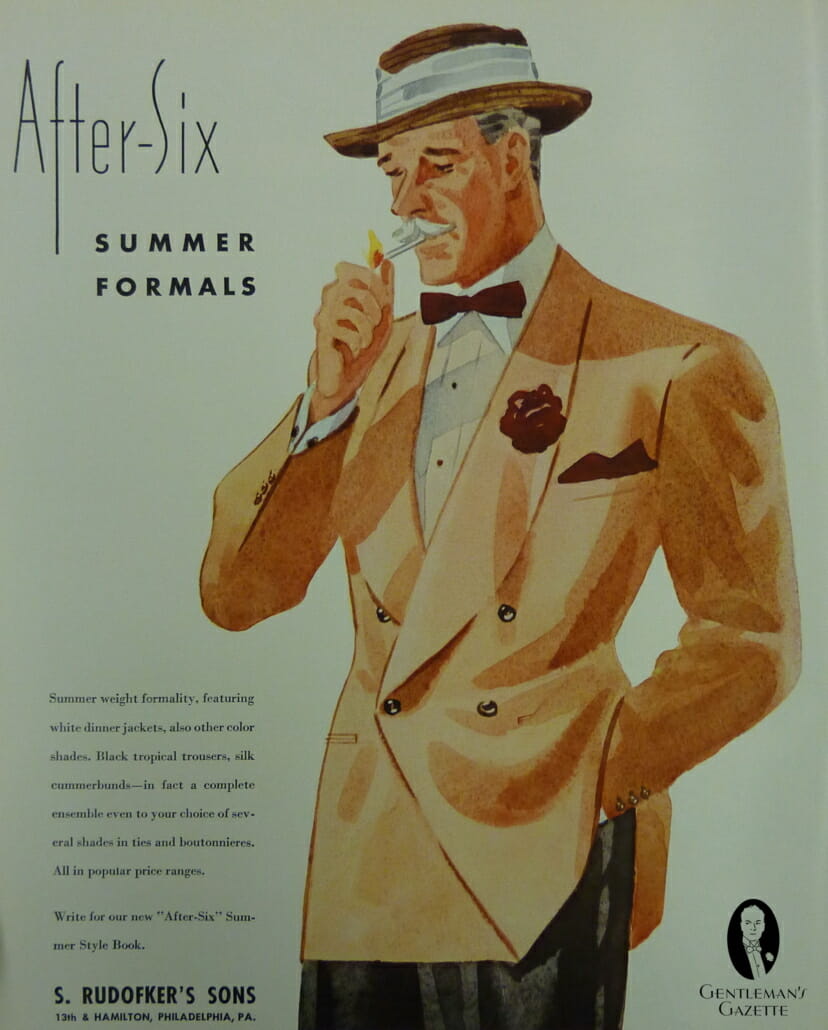
Long-time retailers and manufacturers across America merged with one another to stay viable, either voluntarily or through bankruptcy sales. Predominant among these is After Six, historically the largest and most influential formalwear maker of all. Having just been re-launched this month after two bankruptcies and a liquidation, the history of this illustrious brand is not only an interesting business case study but also a fascinating chronicle of evening wear’s development over the last century.
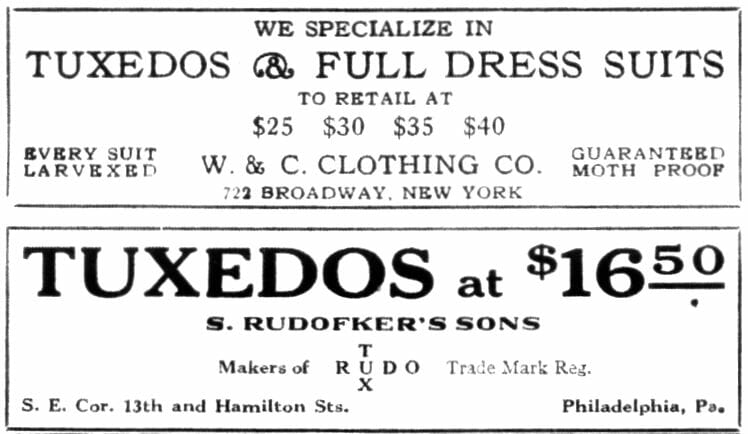
The company was originally founded as S. Rudofker’s Sons in 1903 by Samuel Rudofker, a Ukrainian immigrant who tailored overcoats in his Philadelphia row house. In 1923 it began its long history of formal innovation when eponymous sons Morris and Max introduced the “Rudo Tux”, the first ready-to-wear tuxedo. Priced at only $16.50* it put formal wear within the reach of the working man and was so popular it changed the focus of the company. The Rudofkers are also often credited with pioneering the concept of rented formal wear when they began selling their tuxedos to haberdashers, dry cleaners and tailors with dry-cleaning facilities who in turn acted as dealers for customers requiring temporary formal attire for events and weekends.**

In the 1930s the Rudofker sons decided they needed a new identity for the company that would reflect its evening wear specialization, preferably one that customers could pronounce. As the story goes, the moniker emerged from a brainstorming session that was running late when Max suddenly exclaimed “Oh no, I’ve got to get home for dinner. It’s after six!” The result was the After Six brand – a reference to the etiquette of wearing tuxedos and tailcoats only after 6:00 p.m – which was trademarked in 1937 and eventually incorporated in 1946.
In 1950 After Six debuted the industry’s first celebrity endorsement with a tuxedo named for actor and singer Tony Martin. A few years later they introduced a range of colored dinner jackets for summer evenings making formal wear truly seasonal rather than just a warm-weather substitution of a white jacket. Then in the late ‘50s the company pioneered the first wash-and-wear white dinner jacket which proved to be another huge success.

The 1950’s were also the decade during which the company was passed to Max’s sons one of whom was Sam Rudofker, the new chairman. Under Sam’s leadership After Six began to diversify in 1966 acquiring numerous business that sold garments such as shirts, overcoats and uniforms and in 1969 the company went public.
Another major change during the sixties was the explosion of rental sales. Prior to this After Six had been largely a retail business and the tuxedo was regarded as an unchanging wardrobe staple. Now with the advent of colour a new generation had come to perceive formal wear as a trendy fashion statement instead.
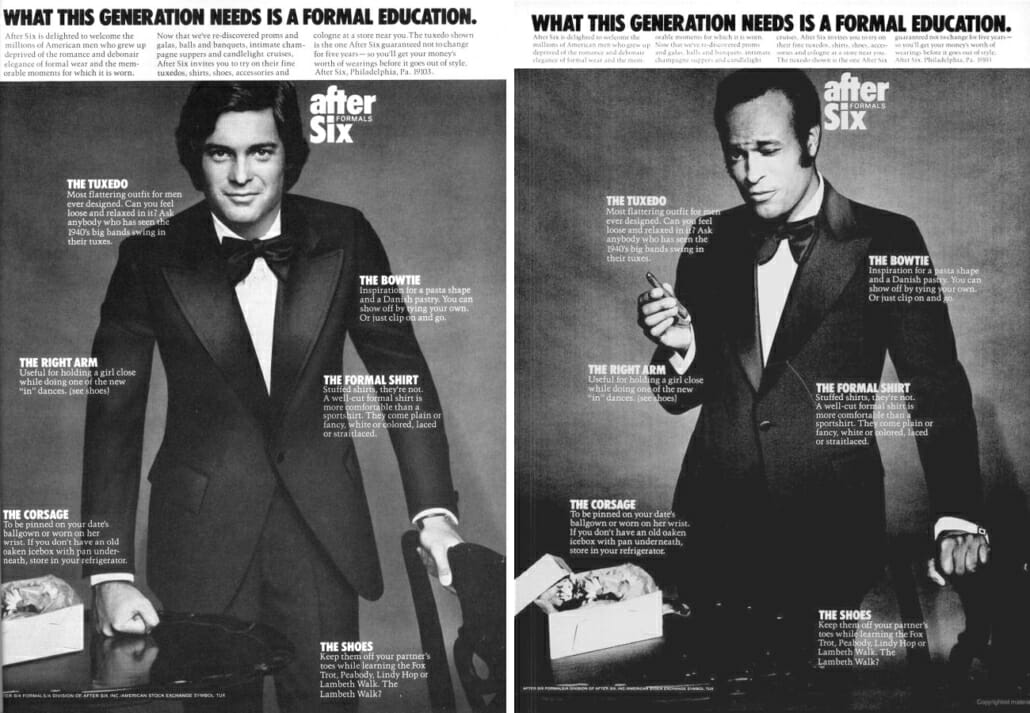
The booming rental trade continued through the 1970s with a wide array of new products. For grooms there were tailcoats and formal day wear in a wide range of peacock tones. For Joe Average there was the brightly hued Arnold Palmer tuxedo line named for the celebrity golfer. And the GQ contingent could indulge themselves in fashionable designer stylings by Oscar de la Renta and Dimitri. The company also offered After Six branded accessories as they licensed their name to suppliers of products such as cufflinks, wrist watches, dress socks, and even prom dresses.
Despite the popularity of the disco era’s unorthodox styles and colours, traditional black tuxedos held their ground and made a welcome comeback in the 1980s as America’s hippies matured into yuppies. After Six embraced the luxury-goods era with new rental and retail lines inspired by the hit TV series Dynasty, Miami Vice and L.A. Law, and upscale offerings from designers Bill Blass, Henry Grethel and Christian Dior.
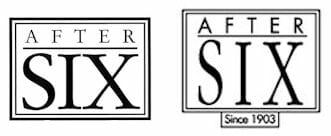
But After Six’s booming sales during this time belied financial conflicts behind the scenes. Concerned by the amount of debt being incurred, Morris Rudofker’s son Bob (who had also joined the firm) threatened his cousin Sam with a proxy fight over the company’s diversification. Consequently Sam resigned in 1981 and Bob took over the reins as chairman.
Then the bubble burst in the late 1980s as the union firm began facing stiff competition from non-union competitors and foreign-made imports. The executives of the company eventually took it private in a leveraged buyout but the resulting $25.5 million of debt left the firm struggling. Ultimately, despite the launch of a Michael Jordan tuxedo line in 1990, After Six filed for bankruptcy in 1993 marking the end of its stewardship by the Rudofker family and its home in Philadelphia.
The first post-Rudofker owner was a Baltimore entrepreneur who quickly snatched up the company but failed to turn it around, sending it back into bankruptcy in 1995. After Six then came under the ownership of a conglomerate called Sequa Group through its subsidiary Chromalloy Men’s Apparel Group (which also owned longtime After Six competitor, Raffinati). Thanks to the skillful leadership of Bob Bennett the company was invigorated with fresh products and award-winning styles which were now made in Athens, Georgia. From 1996 through to 2001 After Six was a manufacturing, marketing and financial machine that made nothing but money for its supporters.
Then came 9/11 and the end of the company’s renaissance. In an attempt to cut costs, manufacturing was outsourced globally but this created its own set of problems and After Six found itself playing catch up instead of remaining the industry leader. In 2008 Sequa decided it had had enough and sold the company to a Michigan-based private equity firm. This time around though there would be no reprieve: the equity firm eventually lost its funding and consequently After Six was shuttered on November 30, 2010 and its remaining inventory liquidated.
And so the story of the original After Six comes to and end . . . yet the saga continues.
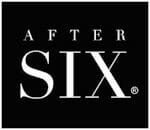
In March 2011 the Dessy Group, a company that had been producing bridesmaids dresses as a licensee of After Six for the previous 14 years, announced it had purchased the rights to the After Six brand and planned to rebuild it. Initially Dessy continued to sell the After Six bridesmaid collection and incorporated the brand into its existing tuxedo accessories then just this month they introduced the Paragon, the first After Six tuxedo sold at retail in over 20 years. Thus begins After Six: The Sequel.
________________________________
Sadly, one of the victims of the recent liquidation is the company’s records which are now lost to history. Therefore I researched this post by compiling numerous online articles from trade journals and the mainstream press and cross referencing them against each other, trademark records and vintage ads to weed out errors and contradictions.
Speaking of ads, I have been working with Dessy Group CEO Alan Dessy in recent months to assemble a comprehensive archive of After Six advertisements. Many of these are now available on the newly re-launched After Six web site and provide a fascinating look at the marketing of the tuxedo for the past century.
________________________________________
Postscripts
July 6, 2012
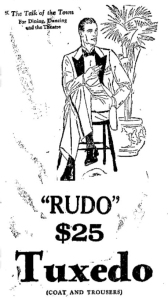
*Although newspaper biographies of After Six state that the original Rudo Tux sold for $16.50 and this claim is seemingly validated by period advertisements such as the one above, this price may not be entirely correct. I recently came across the above 1928 haberdasher ad offering the Rudo at $25. This led me to realize that the period ads I used to validate the $16.50 price are actually from a menswear trade journal and therefore are likely wholesale prices, not prices paid by the consumer. This theory is supported by the other 1925 ad for a Rudofker competitor shown above (from the same trade journal) which specifically states that its tuxedos are “to retail at” $25 and up, putting it on par with the aforementioned 1928 Rudo price.
November 25, 2013
**Subsequent research has revealed that the practice of renting formal attire actually actually dates back to the 1880s and ready-to-wear tuxedos have existed pretty much since the garment’s invention.
May 22, 2104
Dessy has expanded the After Six collection to include a peaked-lapel jacket and shawl-collar jacket.
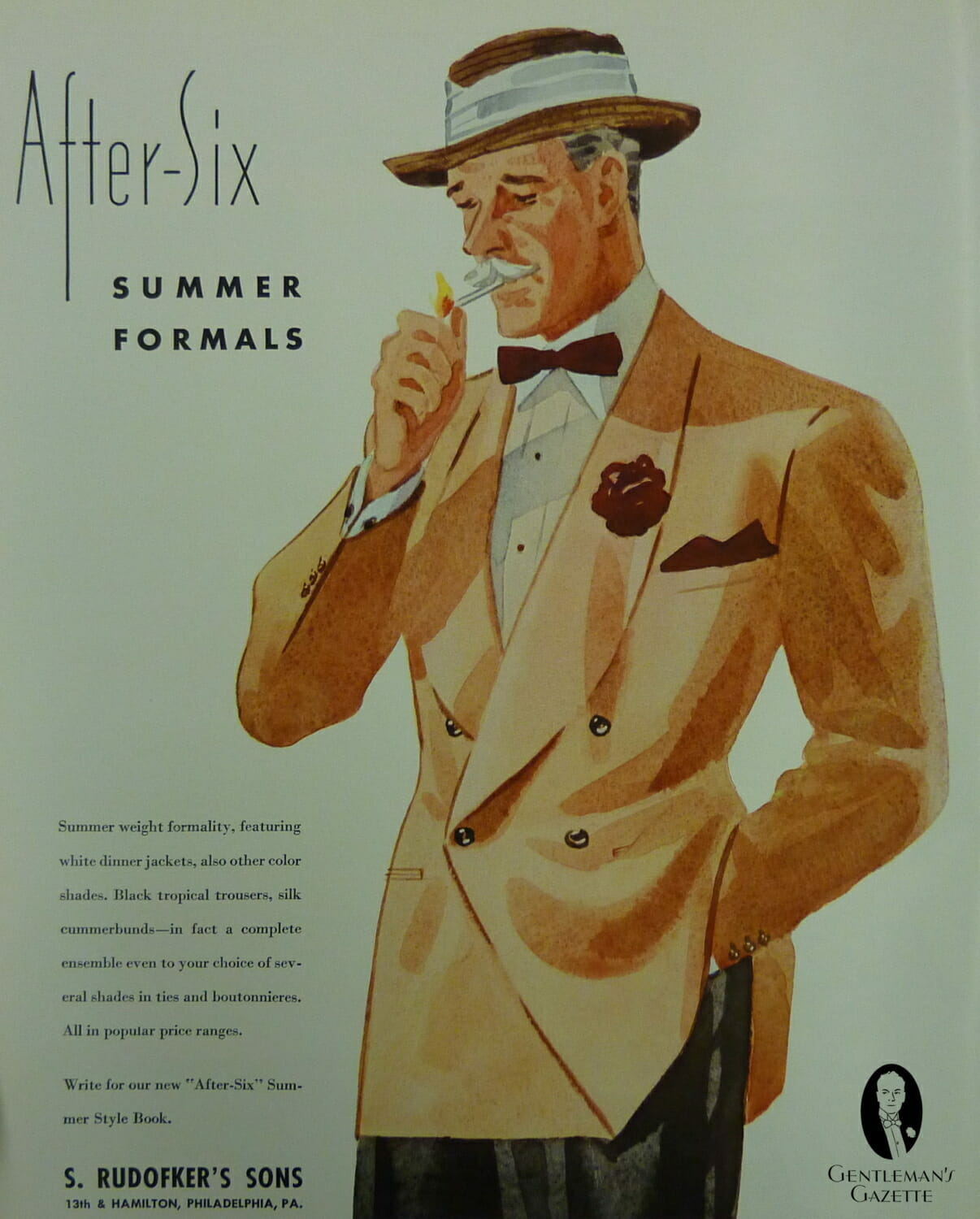
I hope if Alan Dessy reads this he takes it as constructive criticism. I really do want them to succeed, but think they are shooting themselves in the foot if they continue to sell 2000s prom wear.
I’m glad they’re relaunching and all, but the “Paragon” could be a little truer to its name. At least make it a single button if it must be notch lapel. No vents in back, at least, which is a step above President Obama’s own dinner jacket. The lineup of waistcoats, pre-tied bows, neck ties, and cravats are also less than optimal. The Oscars have shown that the current trend is toward classic and younger men want to look more grown up. They are not keeping up with the times.
In fact, beyond having you compile old ads, they should hire you as the style director. You clearly know what you’re talking about if they’ve read the Guide. They’d be wise to listen.
Having worn my first Tuxes at school proms in the late 60’s and early 70’s I am no stranger to The AFTER SIX “brand “and enjoyed reading of it’s history. Your inclusion of the logos throughout the years has allowed me to more closely determine the age of one of my most prized vintage purchases, a narrow shawl collar dj that I purchased at a local Junior League thrift shop For $10. Bearing the label of a quality department store that closed some quarter century ago, I knew that it was old, but checking the label against the illustrations I find that it is even older (1950-58) actually making it of my vintage! It is excellent condition having undoubtedly been hanging for years in some closet until some later generation donated it to charity. It fits well and I have worn it on a recent cruise. I just love the “rat packy” vibe you can almost hear Frank singing…”Come Fly With Me”!
I too, am no stranger to After Six. I had two tuxedos in high school (one that was velvet) and I preferred After Six to all other brands. And I did wear a tux a lot throughout college as well.
As an adult over 30, I bought at least four After Six tuxedos (and appropriate accessories) for dressing for the Symphony and one of these new ones is a tail coat to boot. I think I actually cried when I heard two years ago that After Six was going under. Still not everything that is quality seems to last these days is how I rationalized it.
The great news when Dessy took over was the desire to revitalize this great name. I’m already planning on replacing my getting too small After Six tuxes with the new Paragon version (and provided work treats me right in the form of $$ and the obligations aren’t too bad) and hopefully by next fall’s Opening Night I will be most suitably attired in it. In fact, as a Web Designer, I filled Mr. Dessy in on an error that his Web Master had made and in return I will be treated to a bit off the price when I buy. The main thing is that the venerable name of After Six will be flying again for Black Tie and not buried. Now if we can get rental shops to have French Cuff Tuxedo Dress Shirts for purchase and not just these bad feeling, bad fitting ploy/cotton dress shirts they use now.
This is the only history of After Six, albeit abbreviated, that I have read that is factually accurate. Kudos to the writer, and all the best to Alan Dessy, whom I met many years ago. Alan, keep the legacy alive and well. I expect Samuel, Max, Morris, and Sam are smiling above. Thank you.
Thanks for including the images of the old labels in this great write up! You made this vintage dealer’s research a lot easier!
Thanks for the well-researched article. I recently picked up a couple After Six tuxedos at thrift shops, which happened to be just my size. It is good to learn a bit more about the company behind them.
I have a dynasty black after six with little sparkles nothing but comp, from people. its older but much more elagent then what is out there today
I worked for the Rudofker’s at After Six in Philadelphia 20th Nd Market Streets. Many cells came in to pick up their formal wear, this was in the 70’s.
My Mother worked as. Tailor/ Designer where the coats were made. Great memories there. Thank you for doing this research